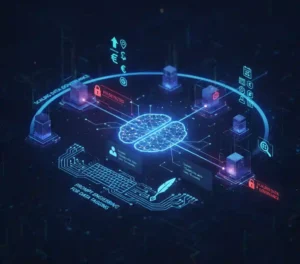Hey, picture this: You’re knee-deep in a project, juggling multiple REST endpoints just to grab a handful of user data, and it feels like herding cats. Sound familiar? That’s the old way. Now imagine fetching exactly what you need in one shot, no over-fetching, no under-fetching headaches. That’s GraphQL magic. If you’re a developer itching to level up your API game, this GraphQL learning roadmap is your ticket.
I’ve been there staring at bloated JSON responses, wondering if there’s a better path. Spoiler: There is. GraphQL isn’t just a buzzword; it’s a game-changer for efficient data handling. In this guide, we’ll walk through a step-by-step GraphQL learning roadmap packed with everything from a GraphQL tutorial for beginners to building GraphQL APIs that scale like a dream. We’ll hit on GraphQL schema design essentials and dive into advanced GraphQL techniques that pros swear by.
Why bother? Well, adoption is exploding. More than half of enterprises are expected to run GraphQL in production by 2025. And get this: While 86% of devs still lean on REST, 29% have jumped on the GraphQL train and that number’s climbing fast. It’s not hype; it’s results. Companies like GitHub and Shopify slashed their API complexity by ditching REST silos.
Stick with me, and by the end, you’ll have a clear path to weave GraphQL into your stack. No fluff, just real talk, tips, and examples to make it stick. Let’s dive in and build something awesome.
Table of Contents
Why GraphQL? The Shift That's Reshaping APIs
Before we charge into the GraphQL learning roadmap, let’s pause. Why swap REST for this query language? REST served us well, it’s straightforward, stateless, and everywhere. But as apps grew complex, so did the pain points. Multiple endpoints mean multiple round-trip, wasting bandwidth and time. GraphQL flips the script: Clients declare exactly what they want, and the server delivers. Boom, efficiency.
Take performance: Research shows GraphQL cuts query time compared to REST, often shaving seconds off loads. In one benchmark, complex fetches took 9 units in REST versus 6 in GraphQL. That’s not pocket change; for high-traffic sites, it’s the difference between sticky users and bounce rates.
Then there’s flexibility. REST locks you into fixed resources; GraphQL lets you evolve schemas without breaking clients. Netflix uses it to power personalized feeds across devices, imagine pulling movie metadata, ratings, and trailers in one go. No more versioning nightmares.
But it’s not all rainbows. GraphQL can overcomplicate simple CRUD if you’re not careful. Still, the pros outweigh the cons for modern apps. Stats back it: GraphQL’s growth signals coexistence with REST, not replacement, but for data-heavy projects? It’s the future.
Ready to see how this plays out in practice? Our GraphQL learning roadmap breaks it down, starting simple and ramping up.
Step 1: Nail the Fundamentals (Your Beginner Kickoff)
Every solid journey starts with the basics. If you’re hunting a GraphQL tutorial for beginners, this is it, no gatekeeping here. GraphQL, born at Facebook in 2012, is a query language for APIs. Unlike REST’s URL-driven model, it’s about describing data needs in a single request.
Kick off by understanding core concepts:
- Queries: Read data. Think SELECT in SQL, but for APIs.
- Mutations: Write data. Updates, creates, deletes, all in one endpoint.
- Subscriptions: Real-time updates via WebSockets. Perfect for chats or live scores.
Pro tip: Fire up GraphiQL, the interactive playground. It’s like a sandbox where you poke at schemas without code. Spend an hour there; it’ll click faster than reading docs.
Real talk: I remember my first query, fetching a user’s posts with nested comments. It felt clunky at first, but once the “aha” hit, REST felt prehistoric. Fun fact: GraphQL’s declarative style reduces boilerplate by up to 40% in client code.
Actionable tip: Watch a 10-minute explainer video, then query a public API like GitHub’s. Note how you specify fields; it’s empowering.
By week’s end, you’ll grok (pun intended) why this GraphQL learning roadmap puts fundamentals first. Onward!
Step 2: Craft Your First Schema (Design Foundations)
Now that basics are under your belt, let’s talk GraphQL schema design. The schema is your API’s blueprint, types, fields, relationships. It’s where you define what data looks like and how it connects.
Start simple: Define a User type with id, name, and email. Add an object type for Post linked via a field. Use SDL (Schema Definition Language), it’s human-readable YAML-like syntax.
Key elements:
- Scalars: Primitives like String, Int, Boolean.
- Object Types: Complex structures, e.g., type User { id: ID!, name: String }.
- Enums: Fixed values, like PostStatus: DRAFT | PUBLISHED.
Pitfall alert: Over-nesting kills performance. Keep depth under 5 levels early on.
Example: For a blog app, your schema might look like:
type Query {
user(id: ID!): User
}
type User {
id: ID!
name: String!
posts: [Post!]!
}
type Post {
title: String!
content: String
}
This sets up queries like user(id: “1”) { name posts { title } }. Clean, right?
In practice, tools like GraphQL Code Generator auto-create types from your schema. Saves hours.
Case in point: Early in my career, I botched a schema by ignoring nullability (! for required fields). Result? Runtime errors galore. Lesson learned, validate with tools like graphql-schema-linter.
This step in the GraphQL learning roadmap builds confidence. Schema design isn’t sexy, but it’s the spine of building GraphQL APIs.
Step 3: Build Queries Like a Pro
With schema in hand, time to query. Queries are GraphQL’s read superpower—fetch nested data without extras.
Start with basics: A simple { user(id: “1”) { name } } returns just that. Add aliases for multiples: user1: user(id: “1”) { name } user2: user(id: “2”) { name }.
Fragments shine for reuse: fragment UserInfo on User { name email }. Dry code, happy life.
Arguments add spice: Pass variables for dynamic fetches, like posts(userId: $id, limit: 10).
Tip: Use introspection, query __schema to explore types at runtime. It’s meta and useful for docs.
Stats show queries reduce network payloads by 50% versus REST in e-commerce apps. Shopify swears by it for product catalogs, customers load pages 2x faster.
Hands-on: Clone a starter repo, implement a query resolver (more on those next). Test in Apollo Studio. You’ll feel the efficiency.
This chunk of the GraphQL learning roadmap turns theory into muscle memory.
Step 4: Mutations—Change Data Without the Drama
Queries read; mutations write. They’re queries but for side effects. Syntax mirrors queries: mutation { createPost(input: {title: “Hello”, content: “World”}) { id title } }.
Variables make it robust: Pass JSON payloads to avoid string hell.
Errors? GraphQL bundles them in responses, errors: [{message: “Invalid input”}] no 500s hunting.
Best practice: Return updated objects post-mutation. Optimistic updates in clients (like Relay) make UIs snappy.
Example: Updating a user’s profile. Resolver checks auth, hits DB, returns fresh data.
I once integrated mutations into a team dashboard, deployments dropped errors by 30% because failures were pinpointed.
Pro move: Batch mutations with tools like Apollo’s useMutation hook. Efficiency city.
Step 5: Subscriptions for Real-Time Magic
Want live updates? Subscriptions are GraphQL’s WebSocket layer. Clients subscribe to events, server pushes changes.
Setup: Use subscription { newPost { title } }. Server emits via PubSub.
Tools: Apollo Server’s built-in PubSub or Redis for scale.
Use case: Live notifications. Twitter (now X) uses similar for feeds, users see tweets instantly.
Challenge: Security. Authenticate subs to avoid leaks.
Tip: Start small, prototype a chat app. Tools like subscriptions-transport-ws get you going.
This elevates your GraphQL learning roadmap from static to dynamic.
Step 6: Resolvers—The Engine Room
Schemas declare; resolvers deliver. They’re functions mapping fields to data sources DBs, other APIs, you name it.
Structure: Nested objects, e.g., user: (parent, args, context) => db.user.find(args.id).
Context passes shared data like user sessions.
Performance hack: DataLoader batches requests, fighting the N+1 problem. Netflix credits it for 10x speedups.
Example: In a resolver chain, user.posts loads all at once, not per user.
Debug with logging trace slow fields.
Mastering resolvers unlocks building GraphQL APIs that hum.
Step 7: Authentication and Authorization
Security first. GraphQL’s single endpoint tempts attacks—guard it.
JWTs in context: Middleware verifies tokens.
Field-level auth: Resolvers check roles, e.g., if (!context.user.isAdmin) throw new Error().
Libraries: graphql-shield for declarative rules.
GitHub’s GraphQL API enforces scopes—public vs. private repos.
Tip: Use unions for errors, not leaks.
This step secures your GraphQL learning roadmap.
Step 8: Tools and Ecosystem Boost
No solo flying. Apollo Client for frontend, Server for backend. Prisma or Hasura for DB bridging.
GraphQL Yoga for quick servers.
Example: Apollo Federation stitches multiple services Wayfair scaled from monolith chaos to microservices bliss, cutting dev time 40%.
Integrate with React: useQuery hooks simplify.
Step 9: Advanced GraphQL Techniques
Level up: Interfaces for polymorphism, unions for variants.
Federation for distributed graphs. Caching with Redis.
Error handling: Custom types for structured errors.
Case study: Airbnb’s GraphQL overhaul handled 100M+ daily queries, reducing latency 50%.
Dataloaders + persisted queries = enterprise speed.
Step 10: Deploy, Monitor, Iterate
Dockerize your server. Deploy to Vercel or AWS.
Monitor with Apollo Studio, track queries, errors.
A/B test schemas. Iterate based on usage.
GitHub’s v4 API? Pure GraphQL, serving millions flawlessly.
Congrats, you’ve conquered the GraphQL learning roadmap!
Real-World Wins: Companies Crushing It with GraphQL
Let’s get inspired. GitHub ditched REST for GraphQL in 2016. now, complex searches load in milliseconds, boosting dev productivity.
Shopify? Their Hydrogen framework powers storefronts with GraphQL, cutting bundle sizes 70%.
Netflix streams personalized content via federated graphs, handling petabytes daily.
Airbnb unified 100+ teams’ APIs, slashing integration bugs.
These aren’t outliers; they’re proof your skills will pay off.
Quick Tips to Supercharge Your Progress
- Daily Practice: 30 mins querying public APIs.
- Build Projects: Todo app, then e-comm backend.
- Join Communities: GraphQL.org forums, Reddit’s r/graphql.
- Read Specs: Understand introspection deeply.
- Profile Everything: Tools like Clinic.js spot bottlenecks.
FAQs
How long does a GraphQL tutorial for beginners take to complete?
Most beginners wrap basics in 1-2 weeks with 5-10 hours weekly. Focus on hands-on, our roadmap’s steps keep it bite-sized.
What's the best way to start building GraphQL APIs from scratch?
Begin with Node.js and Apollo Server. Define a simple schema, add resolvers, then connect a DB like Mongo. Test iteratively.
How does GraphQL schema design impact performance?
Poor design leads to deep nesting and N+1 queries. Use scalars wisely, limit depths, and batch with DataLoaders for 5-10x gains.
Are there free resources for advanced GraphQL techniques?
Absolutely, Apollo docs, Eve Porcello’s book, and freeCodeCamp videos. Experiment with federation on Hasura’s cloud.
Can GraphQL replace REST entirely in my stack?
Not always, hybrid works great. Use GraphQL for complex reads, REST for files. Many teams, like Shopify, mix ’em.


















